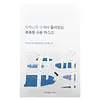What's inside
What's inside
 Key Ingredients
Key Ingredients

 Benefits
Benefits

 Ingredients Side-by-side
Ingredients Side-by-side

Oryza Sativa Extract
AbsorbentWater
Skin ConditioningMethylpropanediol
SolventNiacinamide
SmoothingCetyl Ethylhexanoate
EmollientCaprylic/Capric Triglyceride
MaskingHydrogenated Poly(C6-14 Olefin)
EmollientPolyglyceryl-6 Stearate
EmollientDipropylene Glycol
HumectantSorbitan Stearate
EmulsifyingHydroxyacetophenone
AntioxidantArginine
MaskingCarbomer
Emulsion StabilisingPolyglyceryl-6 Behenate
Emulsion StabilisingCaprylyl Glycol
EmollientXanthan Gum
EmulsifyingAdenosine
Skin ConditioningEthylhexylglycerin
Skin Conditioning1,2-Hexanediol
Skin ConditioningBetaine
HumectantSodium Hyaluronate
HumectantPanthenol
Skin ConditioningSqualane
EmollientDipotassium Glycyrrhizate
HumectantTocopherol
AntioxidantPantolactone
HumectantDisodium EDTA
Oryza Sativa Extract, Water, Methylpropanediol, Niacinamide, Cetyl Ethylhexanoate, Caprylic/Capric Triglyceride, Hydrogenated Poly(C6-14 Olefin), Polyglyceryl-6 Stearate, Dipropylene Glycol, Sorbitan Stearate, Hydroxyacetophenone, Arginine, Carbomer, Polyglyceryl-6 Behenate, Caprylyl Glycol, Xanthan Gum, Adenosine, Ethylhexylglycerin, 1,2-Hexanediol, Betaine, Sodium Hyaluronate, Panthenol, Squalane, Dipotassium Glycyrrhizate, Tocopherol, Pantolactone, Disodium EDTA
Water
Skin ConditioningGlycerin
HumectantMethylpropanediol
SolventPropanediol
SolventBetula Platyphylla Japonica Juice
Skin ConditioningHydroxyacetophenone
AntioxidantCarbomer
Emulsion StabilisingTromethamine
BufferingAllantoin
Skin ConditioningCaffeine
Skin ConditioningPolyglyceryl-10 Laurate
Skin ConditioningPolyglyceryl-10 Myristate
Skin ConditioningButylene Glycol
HumectantCaprylyl Glycol
EmollientXanthan Gum
EmulsifyingEthylhexylglycerin
Skin Conditioning1,2-Hexanediol
Skin ConditioningDipotassium Glycyrrhizate
HumectantSodium Hyaluronate
HumectantDisodium EDTA
Althaea Rosea Flower Extract
Skin ConditioningGlyceryl Caprylate
EmollientWater, Glycerin, Methylpropanediol, Propanediol, Betula Platyphylla Japonica Juice, Hydroxyacetophenone, Carbomer, Tromethamine, Allantoin, Caffeine, Polyglyceryl-10 Laurate, Polyglyceryl-10 Myristate, Butylene Glycol, Caprylyl Glycol, Xanthan Gum, Ethylhexylglycerin, 1,2-Hexanediol, Dipotassium Glycyrrhizate, Sodium Hyaluronate, Disodium EDTA, Althaea Rosea Flower Extract, Glyceryl Caprylate
 Reviews
Reviews

Ingredients Explained
These ingredients are found in both products.
Ingredients higher up in an ingredient list are typically present in a larger amount.
1,2-Hexanediol is a synthetic liquid and another multi-functional powerhouse.
It is a:
- Humectant, drawing moisture into the skin
- Emollient, helping to soften skin
- Solvent, dispersing and stabilizing formulas
- Preservative booster, enhancing the antimicrobial activity of other preservatives
Caprylyl Glycol is a humectant and emollient, meaning it attracts and preserves moisture.
It is a common ingredient in many products, especially those designed to hydrate skin. The primary benefits are retaining moisture, skin softening, and promoting a healthy skin barrier.
Though Caprylyl Glycol is an alcohol derived from fatty acids, it is not the kind that can dry out skin.
This ingredient is also used as a preservative to extend the life of products. It has slight antimicrobial properties.
Learn more about Caprylyl GlycolCarbomer is a polymer of acrylic acid. Its main role is to create a gel consistency.
A high amount of carbomer can cause pilling or balling up of products. Don't worry, most products contain 1% or less of carbomer.
Dipotassium Glycyrrhizate comes from licorice root.
Extracts of licorice have demonstrated to have antibacterial, anti‐inflammatory, antiviral, antioxidant properties.
One component, glabridin, has extra potent antioxidant and soothing properties. It has also been found to block pigmentation from UVB rays in guinea pigs.
Licorice Root also contains a flavonoid. Flavonoids are a natural substance from in plants. Flavonoids also have antioxidant properties.
Another component, glycyrrhizin, has been found to have anti-inflammatory and antimicrobial benefits. This may make licorice root extract effective at treating acne. However, more research is needed to support this.
Liquiritin is one of the flavone compounds found in licorice. It has been found to help lighten skin by preventing tyrosinase from reacting with tyrosine. When the two react, protein is converted to melanin. Melanin is the substance in your body that gives your features pigmentation.
Licorice root is native to Southern Europe and Asia. It has been used in traditional Chinese medicine to help with respiratory issues.
Learn more about Dipotassium GlycyrrhizateDisodium EDTA plays a role in making products more stable by aiding other preservatives.
It is a chelating agent, meaning it neutralizes metal ions that may be found in a product.
Disodium EDTA is a salt of edetic acid and is found to be safe in cosmetic ingredients.
Learn more about Disodium EDTAEthylhexylglycerin (we can't pronounce this either) is commonly used as a preservative and skin softener. It is derived from glyceryl.
You might see Ethylhexylglycerin often paired with other preservatives such as phenoxyethanol. Ethylhexylglycerin has been found to increase the effectiveness of these other preservatives.
Hydroxyacetophenone is antioxidant with skin conditioning and soothing properties. It also boosts the efficiency of preservatives.
This ingredient is not irritating or sensitizing.
Methylpropanediol is a synthetic solvent and humectant.
As a solvent, it helps dissolve other ingredients, helping to evenly distribute ingredients throughout the product. This ingredient has also been shown to have antimicrobial properties which makes it a preservative booster.
Methylpropanediol is able to add a bit of moisture to the skin. It also helps other ingredients be better absorbed into the skin, such as salicylic acid.
Learn more about MethylpropanediolSodium Hyaluronate is hyaluronic acid's salt form. It is commonly derived from the sodium salt of hyaluronic acid.
Like hyaluronic acid, it is great at holding water and acts as a humectant. This makes it a great skin hydrating ingredient.
Sodium Hyaluronate is naturally occurring in our bodies and is mostly found in eye fluid and joints.
These are some other common types of Hyaluronic Acid:
Learn more about Sodium HyaluronateWater. It's the most common cosmetic ingredient of all. You'll usually see it at the top of ingredient lists, meaning that it makes up the largest part of the product.
So why is it so popular? Water most often acts as a solvent - this means that it helps dissolve other ingredients into the formulation.
You'll also recognize water as that liquid we all need to stay alive. If you see this, drink a glass of water. Stay hydrated!
Learn more about WaterXanthan gum is used as a stabilizer and thickener within cosmetic products. It helps give products a sticky, thick feeling - preventing them from being too runny.
On the technical side of things, xanthan gum is a polysaccharide - a combination consisting of multiple sugar molecules bonded together.
Xanthan gum is a pretty common and great ingredient. It is a natural, non-toxic, non-irritating ingredient that is also commonly used in food products.
Learn more about Xanthan Gum